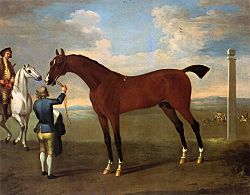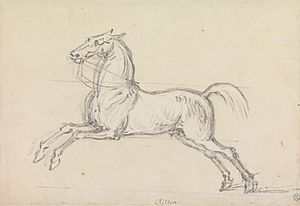Flying Childers facts for kids
Quick facts for kids Flying Childers |
|
|---|---|

Flying Childers by James Seymour
|
|
| Sire | Darley Arabian |
| Dam | Betty Leedes |
| Damsire | Old Careless |
| Sex | Stallion |
| Foaled | 1715 |
| Country | Great Britain |
| Colour | Bay |
| Breeder | Colonel Leonard Childers of Cantley Hall |
| Owner | 2nd Duke of Devonshire |
| Record | 6 starts, 6 wins |
| Awards | |
| Leading sire in GB and Ireland (1730, 1736) | |
| Honours | |
| Flying Childers Stakes at Doncaster Racecourse | |
Flying Childers (born 1715, died 1741) was a super famous racehorse from the 1700s. He was born in Doncaster, England, and never lost a race! Many people think he was the very first truly great racehorse ever, and he really captured everyone's attention.
Contents
Who Was Flying Childers?
Flying Childers was a special type of horse called a thoroughbred. These horses are known for their speed and are often used for racing. He was born in 1715 at Carr House in Warmsworth, Doncaster. People often called him "Devonshire Childers" or "Childers" because of his owner, the Duke of Devonshire, and his breeder, Colonel Leonard Childers.
His Family Tree: Breeding and Parents
Flying Childers had a very important dad named Darley Arabian. Darley Arabian was one of the three main horses that started the entire thoroughbred horse breed! His mom was named Betty Leedes. She was also the mother of another famous horse called Bartlett's or Bleeding Childers.
Betty Leedes was one of the few outside mares allowed to breed with Darley Arabian. This was because Darley Arabian was usually kept as a private horse by his owner.
Racing Career: An Unbeaten Champion
Flying Childers started racing when he was six years old. He was a tall horse, about 15.2 hands high (which is about 157 cm).
His first race was in April 1721 at Newmarket, where he beat a horse named Speedwell. He won his second race easily in October, also at Newmarket. His third win was against a horse named Almanzor. People said he finished this race super fast, in just 6 minutes and 40 seconds! This speed was so amazing that some claimed he was as fast as another legendary unbeaten horse named Eclipse.
When he was seven years old, he won his only race that year, beating a horse named Chaunter. In 1723, he won both of his races without even having to run, because the other horses gave up! After these wins, Flying Childers retired from racing to become a breeding horse.
Race Wins Summary

| Date | Race name | Distance (miles) | Course | Prize | Runners | Place | Runner-up |
|---|---|---|---|---|---|---|---|
| April 1721 | Match race vs. Speedwell | 4 | Newmarket | 500 guineas | 2 | 1 | Speedwell |
| October 1721 | Match race vs. Speedwell | not known | Newmarket | 500 guineas | 2 | 1 | forfeit |
| 1721 | Trial vs. Almanzor and Brown Betty | 4 | Newmarket | none | 3 | 1 | not known |
| October 1722 | Match race vs. Chaunter | 6 | Newmarket | 1000 guineas | 2 | 1 | Chaunter |
| April 1723 | Race vs. Stripling and Bridgewater's Lonsdale Mare | not known | Newmarket | 100 guineas | 3 | 1 | forfeit |
| November 1723 | Match race vs. Bobsey | not known | Newmarket | 100 guineas | 2 | 1 | forfeit |
Life as a Breeding Stallion
After his racing days, Flying Childers became a private breeding horse, called a stallion. He lived at the Duke of Devonshire's estate in Derbyshire until he passed away in 1741 at 26 years old.
He had many important children who also became great racehorses or parents of other famous horses. Some of his most notable offspring included:
- Blacklegs (born 1728): A successful racehorse and father of other horses.
- Snip (born 1736): Even though he wasn't a great racer, he became the father of a very important stallion named (Old) Snap.
- Second (born 1732): This horse beat two other famous horses, Sultan and Partner, in 1737.
- Blaze (born 1733): Blaze was super important! He had many famous children, including Shales (who helped start the Hackney horse breed) and Messenger. Messenger is known as the main father of the Standardbred horse breed and was very important for the Tennessee Walking Horse.
Flying Childers was also the grandfather of another very important thoroughbred father, Herod.
When he died, people said he was "the fleetest horse that ever ran at Newmarket or, as generally believed, that was ever bred in the world." This shows how truly special he was!
His Lasting Legacy
Flying Childers was so famous that even pubs were named after him! You can find "The Flying Childers Inn" in places like Bessacarr in Doncaster, Stanton in Peak, Derbyshire, and Kirby Bellars, Leicestershire. This shows how much people admired this amazing horse.
See also
- List of leading Thoroughbred racehorses

